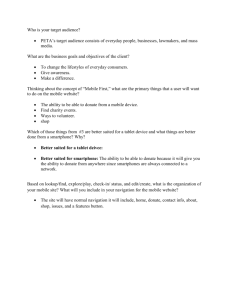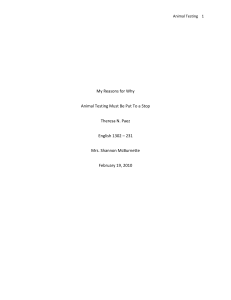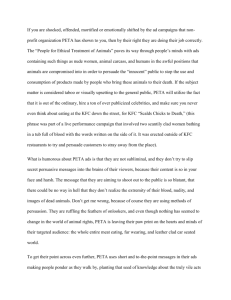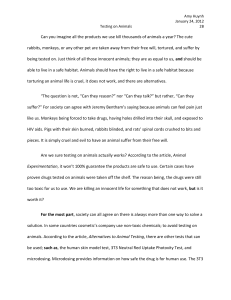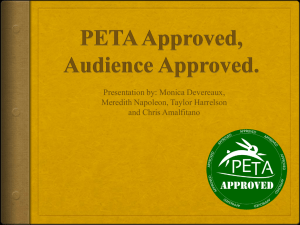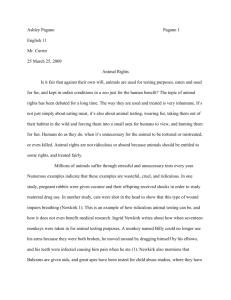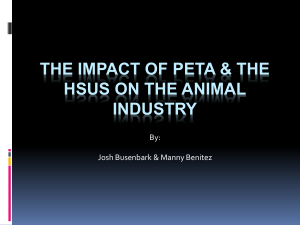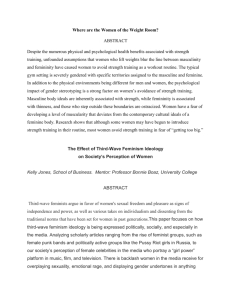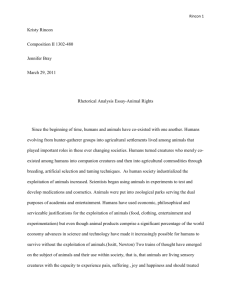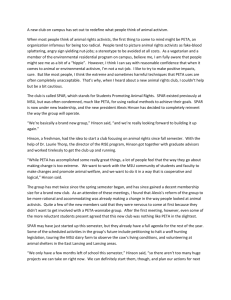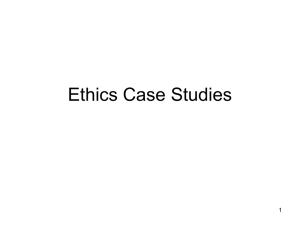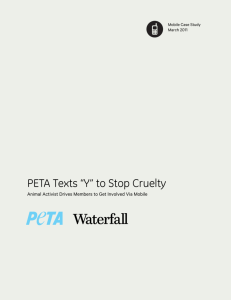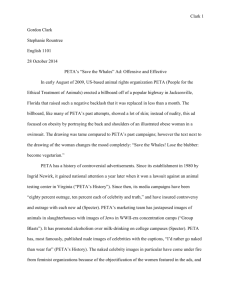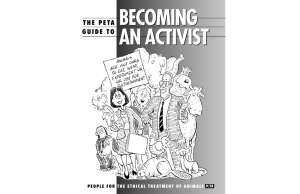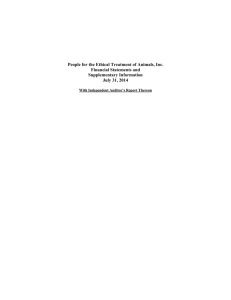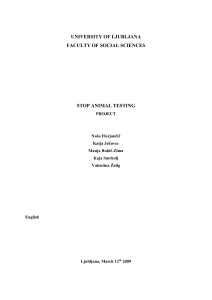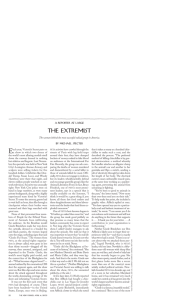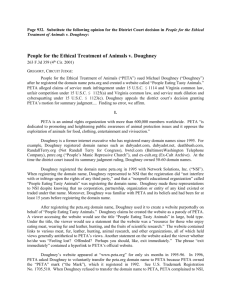Lanham Animal Testing: Government Regulated Murder Animal
advertisement
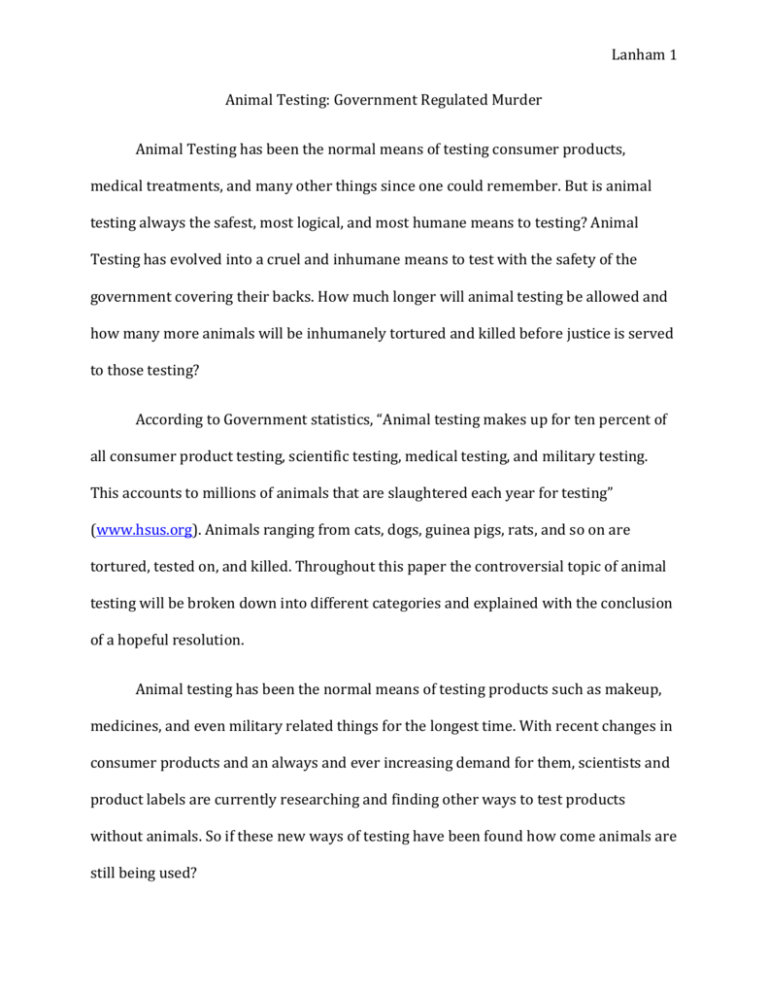
Lanham 1 Animal Testing: Government Regulated Murder Animal Testing has been the normal means of testing consumer products, medical treatments, and many other things since one could remember. But is animal testing always the safest, most logical, and most humane means to testing? Animal Testing has evolved into a cruel and inhumane means to test with the safety of the government covering their backs. How much longer will animal testing be allowed and how many more animals will be inhumanely tortured and killed before justice is served to those testing? According to Government statistics, “Animal testing makes up for ten percent of all consumer product testing, scientific testing, medical testing, and military testing. This accounts to millions of animals that are slaughtered each year for testing” (www.hsus.org). Animals ranging from cats, dogs, guinea pigs, rats, and so on are tortured, tested on, and killed. Throughout this paper the controversial topic of animal testing will be broken down into different categories and explained with the conclusion of a hopeful resolution. Animal testing has been the normal means of testing products such as makeup, medicines, and even military related things for the longest time. With recent changes in consumer products and an always and ever increasing demand for them, scientists and product labels are currently researching and finding other ways to test products without animals. So if these new ways of testing have been found how come animals are still being used? Lanham 2 Animals that are tested on makeup and beauty products is still a common occurrence within the makeup industry. Many rats and mice are used for the main testing of the product. According to an article done by a reporter at the Washington Post, “Each year, American doctors inject more than 3 million doses of Botox to temporarily smooth their patients' wrinkles and frown lines. But before each batch is shipped, the manufacturer puts it through one of the oldest and most controversial animal tests available. To check the potency of its product under federal safety rules, Allergan Inc. injects mice with Botox until it finds a dose at which half of the animals die – a rough gauge of potential harm to humans” (www.washingtonpost.com). Even though this is an extreme case of animal testing it is still a valid form of testing and shows the cruelty involved. Animals involved with medical testing see the harsher end of the testing spectrum. Since many medicines are already considered dangerous and unsafe many animals are killed in this testing process. According to medical testing records, “Many animals go through harsh and deadly tests that involve: the testing of new medicines not yet used in the field that could possibly contain high and unsafe potencies and animals being tested on with new forms of plastic surgery and anesthetics” (www.dosomething.org). Although animals have been used for medical testing they are actually finding out that many medicines tested on animals have caused severe negative effects on humans. According to an article by the organization PETA, “A 2002 report in the Journal of the American Medical Association found that in the last 25 years, more than 50 FDA-approved drugs had to be taken off the market or relabeled because they Lanham 3 caused “adverse reactions” (www.peta.org). In 2000 alone, the prescription drugs removed from the market were the popular heartburn drug Propulsid (removed because it caused “fatal heart rhythm abnormalities”), the diabetes drug Rezulin (“removed after causing liver failure”), and the irritable-bowel-syndrome treatment Lotronex (“removed for causing fatal constipation and colitis”). According to the study’s lead author, “Millions of patients are exposed to potentially unsafe drugs each year. If the pharmaceutical industry switched from animal experiments to quantum pharmacology and in vitro tests, we would be better protected from harmful drugs, not less protected” (www.peta.org). With these facts and statistics it is clear that animals used for medical testing is not always the best or safest option. There have been several reported cases of intense and inhumane cruelty involved with animal testing involving the military. Military intelligence uses dogs and cats to test bombs, radiation, gases, and other weapons. In one test the military uses, a dog that is put an a long glass tube and a gas is put into the tube causing the animal to immediately look for an escape in which there isn’t one. The dog ends up foaming at the mouth and convulsing violently until it dies within minutes. The purpose of the test they say is to see the dog’s “reaction time” to the chemical. In another test an arms specialist would show army personnel the power or range of a certain weapon by hanging a cat by its feet, letting it hang upside down at one end of a room and the group stand at the other end, and the specialist aims and fires the weapon at the cats head killing it instantly (www.peta.org). Although these are extreme cases of animal testing these tests still infringe on the humanity and rights of animals. Lanham 4 Many organizations have become aware of the cruelty involved with animal testing and have decided to make a change about it. Medical students in Great Britain are not allowed to use animals to practice their professions on by order of law. According to the highly recognized animal rights organization PETA, “Many of the leading U.S. medical schools, including Harvard, Yale, and Stanford, now use innovative, clinical teaching methods instead of cruel animal laboratories. Harvard, for instance, offers a cardiac-anesthesia practicum in which students observe human heart bypass operations instead of performing terminal surgery on dogs” (www.peta.org). With these changes in animal testing and organizations that use animals, an example is being set and clearing the way for animals to no longer be used for inhumane tests and torture. Many people see the inhumanities in the testing’s that are taking place and are making a stand about it. Many organizations such as PETA and other animal rights activist groups boycott certain organizations due to animal testing or the inhumane use of animals. Many extremists for animals’ rights rally and protest in various forms. Some extreme cases of protesting are humans dressing up like animals and caging themselves in front of fur shops, medical facilities, and certain industries known for animal cruelty or animal testing. While it is known that animal testing is wrong and inhumane, and many people are making a stand about it, more can be done to fight against the common and continued use of animal testing no matter how minimal it is. Certain things that can be done to help fight for animals rights are helping it be Lanham 5 known to the public and making it a common awareness for people. One can boycott certain industries and products that use animal testing or condone it. One can also, if feeling passionate enough or extreme enough about the topic, take place is a protest or a rally against testing on animals and cruelty towards animals. In conclusion animal testing, although becoming a thing of the past, is still very common and relative today. Many industries and companies still practice animal testing without the government making a stand against it. It is up to us, the people to make a stand against it and fight for what is right. Without animal testing we are ensuring a better future for ourselves and for all creatures of the earth. Lanham 6 Works Cited "Animal Testing." Dictionary.com's 21st Century Lexicon. Dictionary.com, LLC. 25 March 2010. http://dictionary.reference.com/browse/animal testing. 11 Facts About Animal Testing.” Do Something. March 25, 2010 http://www.dosomething.org/tipsandtools/11-facts-about-animal-testing. "Animal Testing.” The Humane Society of the United States. March 25, 2010 http://www.hsus.org/animals_in_research/animal_testing/. Animals Used for Experimentation FAQs." PETA. March 25, 2010 http://www.peta.org/ABOUT/faq-viv.asp. Animal Testing." PETA. March 25, 2010 http://www.peta.org/actioncenter/testing.asp. Lanham 7 Gilbert, Gaul. "In U.S., Few Alternative to Animal Testing.” The Washington Post. March 25, 2010 http://www.washingtonpost.com/wpdyn/content/article/2008/04/11/AR2008041103733.html.
